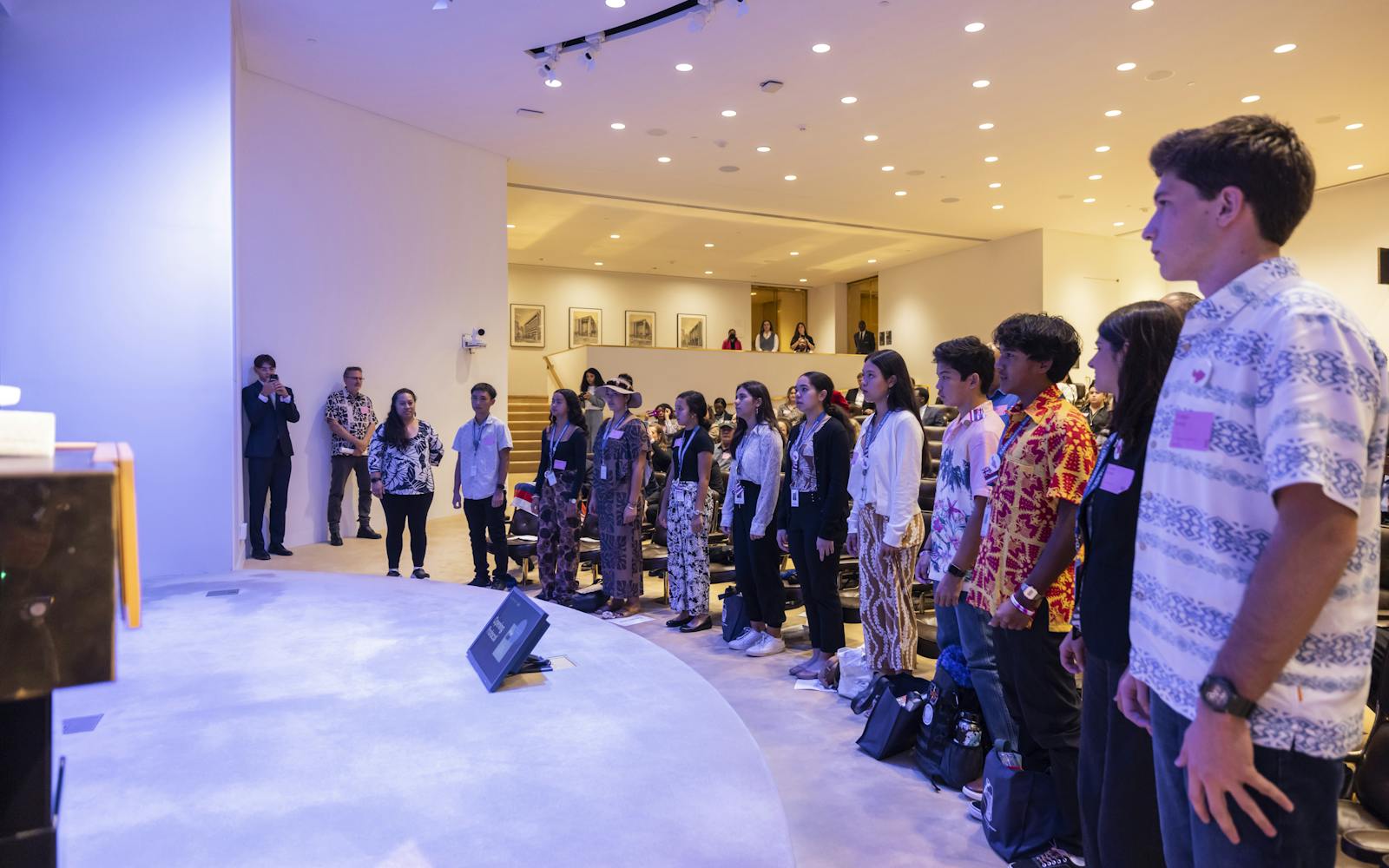
Young changemakers shared their insights at the American Leaders Advancing the SDGs event at UNGA 78, co-hosted by UN Foundation and the Center for Sustainable Development at the Brookings Institution. Photo: UN Foundation/Carbon Stories
Today’s youth face a stark choice: accept the status quo and inherit the chaos that comes with it, or forge a new fate by building a better future for all. For a growing number of young people across the United States, the Sustainable Development Goals offer a galvanizing blueprint for action over apathy and collaboration over crisis.
The Sustainable Development Goals represent the future we want: one rooted in equality, justice, prosperity, and peace. But what do those who will inherit the future really think about the Global Goals? I set out to better understand how young people across the United States are thinking about the future and rallying around the SDGs. From Los Angeles to Philadelphia, Honolulu, and Rochester, New York, the young people I spoke to made clear: America’s youth are taking notice of the existential challenges the world is facing, and they are harnessing the unifying power of the SDGs to take action.
I spoke with 10 young leaders about how they view and act on the SDGs, what meaningful youth engagement looks like, and what excites and worries them as they think about 2030 — the deadline for the Global Goals, and the year some of them will graduate from college. I heard from middle schoolers just entering their teen years and those who are nearing the end of their 20s. I talked to a high school senior, a doctoral student, and a second-year teacher. Each conversation provided unique insight into how the SDGs are a beacon and a blueprint for the next generation. While each individual had a different perspective and point of entry on the Global Goals, our conversations made clear that the SDGs matter to America’s young people, who see the value of acting both locally and globally. It will take all of us to achieve the Goals — and emerging leaders of all ages are stepping forward to help us get there.
While awareness of the SDGs is relatively low across the U.S., the young leaders I spoke to get it. Many of these rising leaders learned about the 2030 Agenda and its 5 Ps (People, Planet, Prosperity, Peace, and Partnership) only just recently, but they’re already integrating the SDGs into how they’re thinking about their lives and their futures. They connect with the Goals through coursework, classroom curricula, and research; by engaging directly in legislative processes; through national advocacy on Capitol Hill and in their communities; by participating in global programs and at the UN; and through conversations with parents, mentors, teachers, and elders. In each of these spheres, the young people I spoke to feel they are just getting started and that they have the capacity to contribute and achieve more.
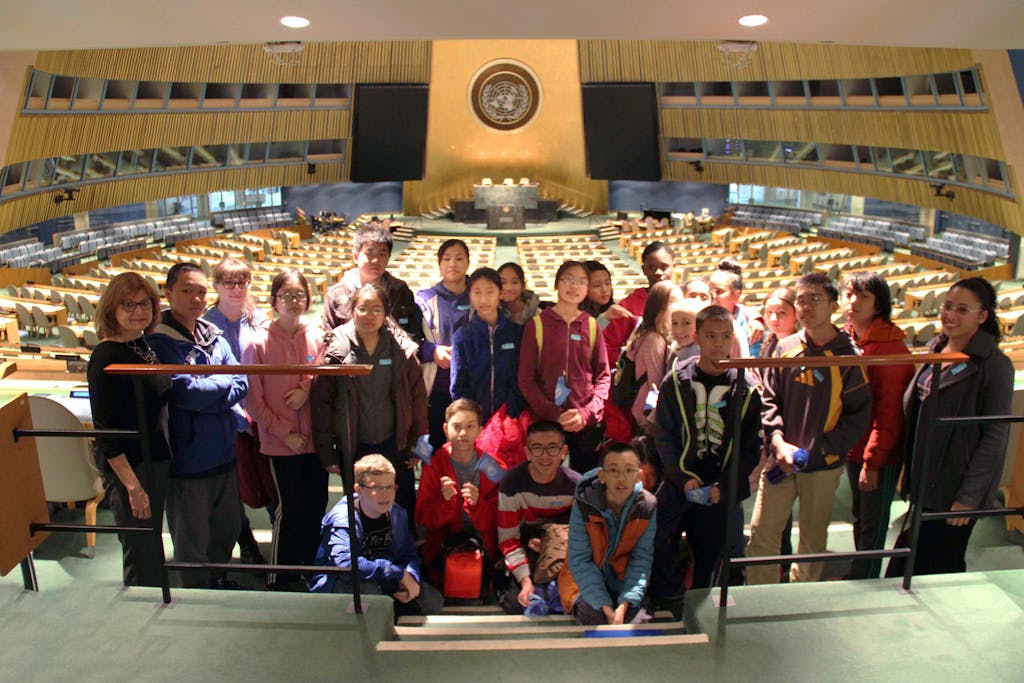
UN Junior Ambassadors visit the UN General Assembly Hall in New York, New York.
Photo: Janice Wong
Meaningful Engagement Takes Many Forms
Through Learning — and Teaching
The SDGs correlate with local problems — and solutions — while offering connection to a wider world. Thirteen-year-old Camil Demirovic at Marsh Avenue School for Expeditionary Learning on Staten Island says participating in New York City’s Junior Ambassadors program was the first time he ever heard about the SDGs, or thought deeply about the UN. Through field trips and in-person meetings with UN and city officials, students like Camil are discovering the relevance of the Global Goals by examining housing affordability, public transportation, and other local challenges. Since the program’s launch, more than 5,300 students across New York City have participated in it.
Learning about such universal challenges as poverty, inequality, and access to education made Camil realize how all of these social issues are tied together. He can see how income and inequality in his own borough affects which public schools are considered to be good or bad.
“In my own community, there is a big role for a lot of these Goals,” he says.
For Camil’s eighth grade social studies teacher, 24-year-old Janice Wong, the NYC Junior Ambassadors program offers a compelling, hands-on way to teach students how to see themselves as New Yorkers, Americans, and global citizens. Wong, who is completing her second year of teaching, believes this kind of international curriculum should be taught at an early age in the U.S. so young people can be better equipped to navigate the complicated and interconnected global reality that awaits them after graduation.
“When I became a teacher, I swore that I would implement a new curriculum that my students would feel connected to and feel like they could have their voice heard,” she said. “What’s better than a program where students are able to not only have their voices heard, but pitch programs to create change in their own community?”

Camil Demirovic from Staten Island, New York is passionate about the connection between poverty, inequality, and education. Photo: Camil Demjrovic
Through Policy
To Kinohi Souki, a rising 10th grade student at Kamehameha Schools in Hawaiʻi, the SDGs echo and reinforce the ancient wisdom of Indigenous ways of living. Describing the Global Goals as “the world’s most important to-do list,” she says young people and adults alike need to remember what achieving them could actually mean. Achieving the Goals is possible, she says, but only if action is taken now. “If we keep the same lifestyle that we have now, we’re not going to be able to make these goals,” she says.
“We can do more than plant trees and beach cleanups,” Kinohi says of her classmates, 12 of whom have an official role in Hawaiʻi’s inaugural SDG Youth Council. “We can help with legislative decisions. We can help with government policy. We can help with global decisions at the UN.”
Kinohi speaks from experience. At this year’s Hawaiʻi Sustainability Summit, she met and mentored other students from Hawaiʻi County as they developed legislation to advance the SDGs that will be presented at the state Legislature’s upcoming session. She says she was amazed at the enthusiasm she encountered, which only reaffirmed what she already knew, even at 15: “When you let a kid dream, they can really just take over the world.”
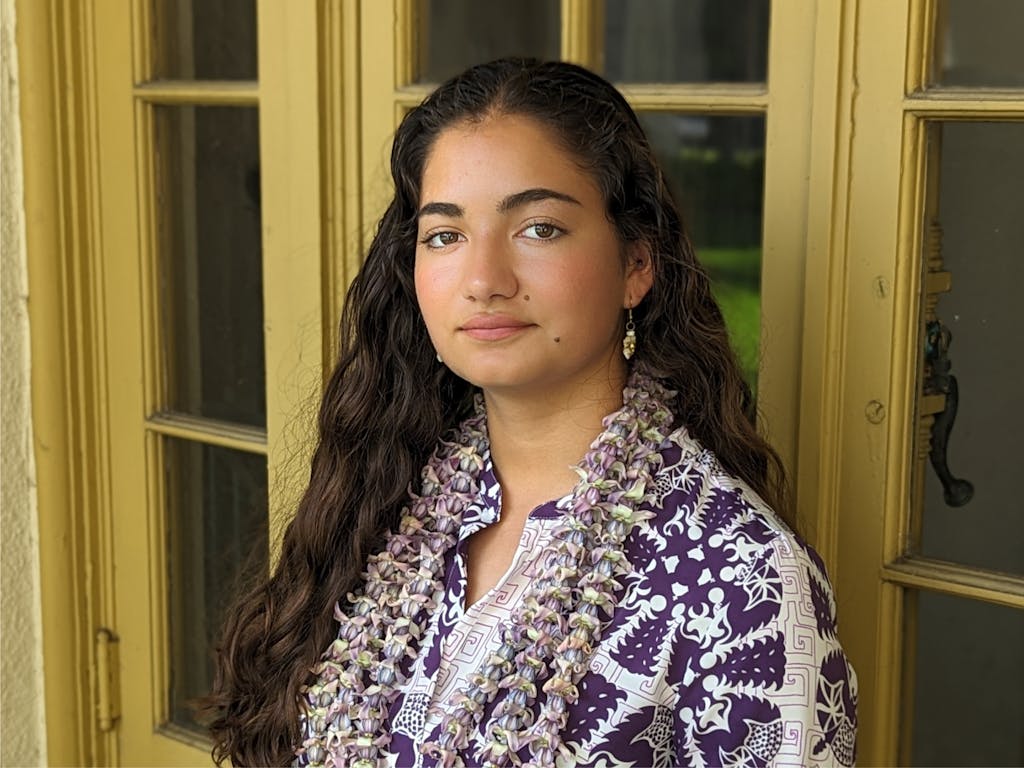
To Kinohi Souki, a rising 10th grade student at Kamehameha Schools in Hawaiʻi, the SDGs echo and reinforce the ancient wisdom of Indigenous ways of living. Photo: Kinohi Souki
Through Community Art
For Faysal Adger, an 18-year-old mural artist, childhood cancer survivor, and soon-to-be culinary arts student from Philadelphia, engaging on the SDGs means painting.
He learned about the SDGs through Global Philadelphia’s 17 SDG Murals Project, which connects the Global Goals with a thriving local artscape of more than 4,000 murals in America’s first World Heritage City.
Each SDG mural also connects with a donation from a local organization to a nonprofit that is advancing that specific Goal. Faysal envisions his SDG 8 mural as connecting people, nature, and technology, while showing how technology is pushing us forward to improve agriculture. He appreciates how both the SDGs and art bring people in his community together. “It’s amazing,” he says, “because I never thought I would be able to leave my mark on the world, especially at a young age. Now I have two murals in Philadelphia and am making one for my school.”
Faysal emphasized that people of all ages have something unique to offer — not just young people. “Instead of grouping everyone together as one,” we should look at and respond to each other as individuals, he says.
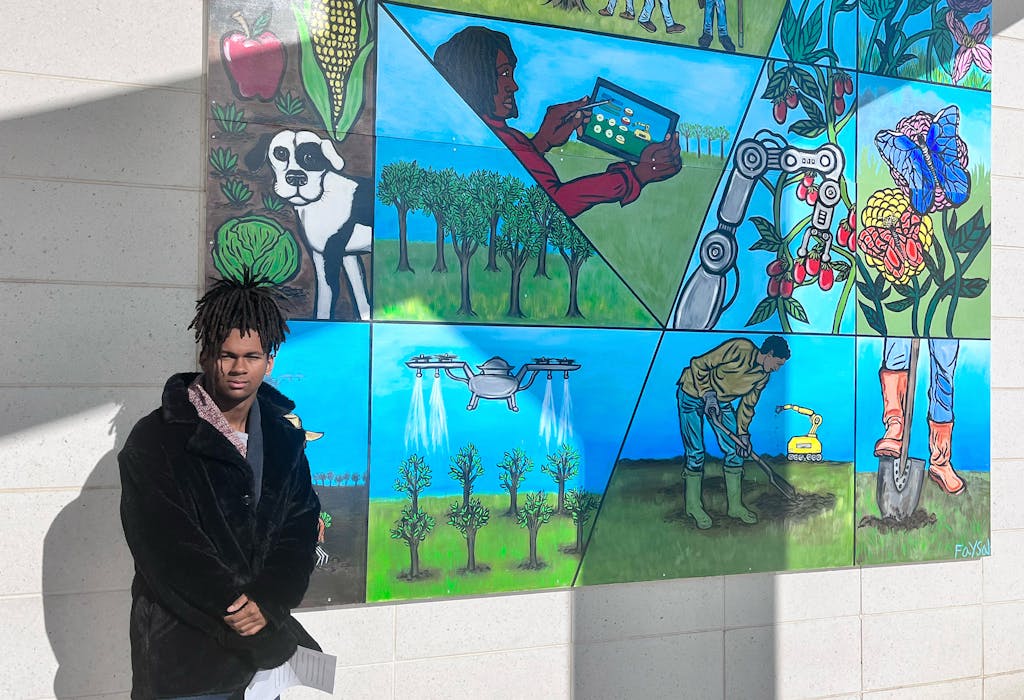
Philadelphia student Faysal Adger is bringing the SDGs to the heart of his community through vibrant art. Photo: Faysal Adger
Through Grassroots Advocacy
As a Global Goals Ambassador for the United Nations Association of the USA (UNA-USA), 27-year-old Virgil Parker is focused on elevating underrepresented communities and emphasizing education as a crucial pathway out of poverty. He sees a lack of SDG awareness in the U.S. as a barrier to progress. “Most people are probably familiar with the United Nations, of course, but there are still so many everyday people who don’t know what the SDGs are,” he says. “They don’t know how critical the 2030 Agenda is, and how we’ve been put off track because of the pandemic and lost progress around health, poverty, and education.”
Virgil believes rallying young people around the SDGs right now will be especially important in the long run. “You’re looking at future professionals, public servants, leaders, and executives who can continue on the path of whichever one or more of the SDGs they decide to support or feel most passionate about,” he says. “It sounds grandiose, but we can all do our part in our community to ensure that America is achieving these global objectives.
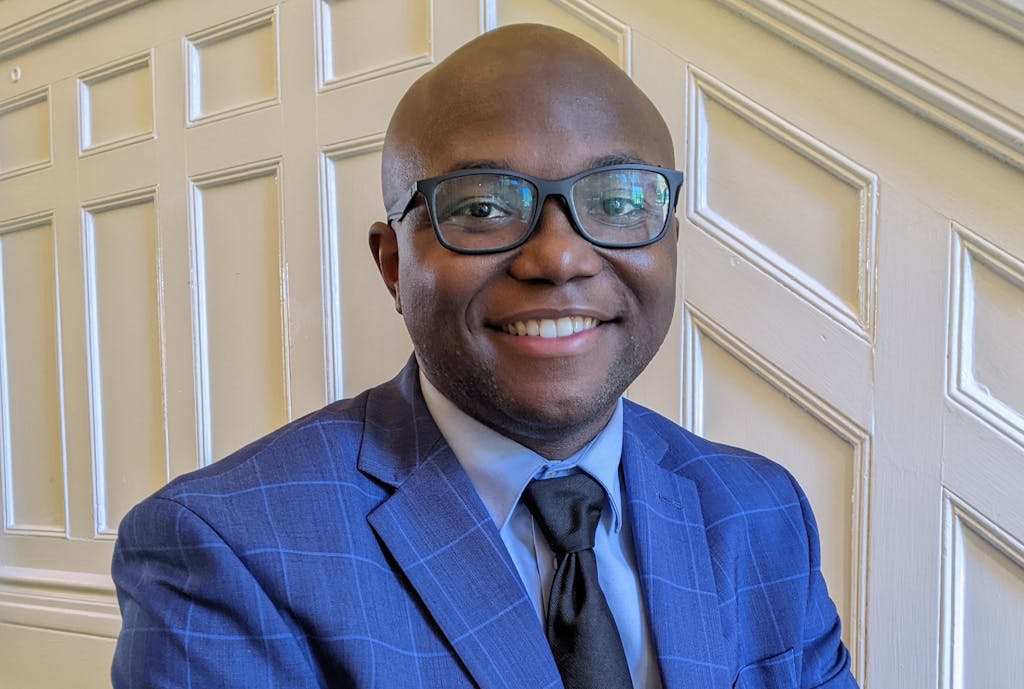
Virgil Parker, a Global Goals Ambassador for UNA-USA, is using grassroots advocacy to advance the SDGs. Photo: Virgil Parker
Through Leadership at the UN
Saru Duckworth, who will turn 26 at the end of this month, is a Nepalese American researcher and activist and current graduate student at Columbia University’s School of International and Public Affairs. She is one of 10 global Next Generation Fellows, a program established by the UN Foundation that seeks to bridge the gap between local action and global solutions by putting young people at the forefront of the international system.
One of Saru’s main priorities is strengthening dialogue between UN officials and young people, including those represented by the Unlock the Future coalition, a network of the planet’s 25 largest youth organizations, including Save the Children, BRAC, the Girl Scouts, and the YMCA. “We have to mainstream civil society into the political processes at the UN,” she says. After all, she points out, civil society will ultimately be responsible for putting these treaties into practice. Saru also wants to see more input from young people and civil society when it comes to such global documents as the Pact for the Future, which will be negotiated at the historic Summit of the Future in September.
The upcoming Summit of the Future offers an opportunity for intergenerational problem-solving. At a critical moment on the SDGs, the events of this September look to advance the world’s existing commitments and turbocharge bold, new action.
Achieving the 2030 Agenda will require advocacy, leadership, and input at all levels of power. And young people need to be at the forefront of each, Saru says. She calls for intergenerational collaboration and cites recent developments such as the launch of the UN’s Youth Office as hopeful signs that young people are being taken seriously on the global stage.
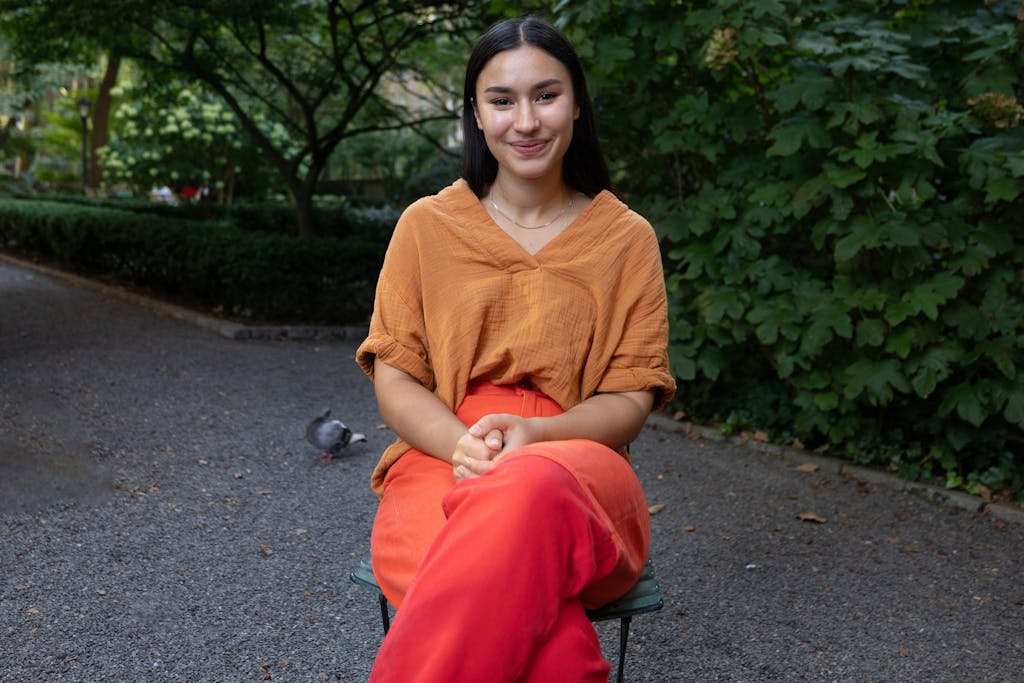
Nepalese American researcher and activist Saru Duckworth is shining the light on SDG 1 through her work with Columbia University and UN Foundation’s Next Generation Fellows program. Photo: Saru Duckworth
SDG Action From All of Us
Across all 10 conversations, I heard loud and clear: Young people in the U.S. want more than symbolic roles or tokenized opportunities to sit on the sidelines and witness decisions being made about their future. They are keen to continue their learning journeys while having a real voice and consequential role in shaping decisions that will affect their present and future.
Each of these actions recognizes that young people are critical to achieve results that last. Through art, academics, advocacy, and awareness-raising, youth across the country are demonstrating how their unique perspectives, passion, and fresh ways of thinking are sparking local-to-global progress. Everyone we spoke to had a lot to say, and despite the headlines all around us, it wasn’t all doom and gloom. Across all issue areas, there are passionate young people with something to contribute.
From classrooms and communities to the halls of Congress and the United Nations, young people across the U.S. are advancing progress on the Global Goals at a pivotal moment for future generations — and the fate of the planet. American youth are engaged, and they are taking action in their communities. Through dialogue and intentional collaboration, communities across the U.S. can continue to gather momentum and mobilize resources and political will to achieve the SDGs — with young people at the table.
I’d add that to affect the systems change required to achieve the SDGs, we also need to update how leaders design and implement these systems by integrating the principles of leaving no one behind in the process itself, not just in the outcomes. Speaking with these young people has reminded me that change can indeed move quickly, and I’m inspired to imagine a 2030 in which the SDGs have been realized.
Author’s note: A sincere thank you to the young leaders who shared their perspectives for this blog: Faysal Adger (Philadelphia); Purva Bommireddy (Pittsburgh); Camil Demirovic (Staten Island); Saru Duckworth (Manhattan, currently in Dakar, Senegal); Gaea Morales (Los Angeles, currently in Bangkok, Thailand); Jennifer Borrero (Atlanta); Virgil Parker (Rochester); Prishaa Shrimali (Edgewater, New Jersey); Kinohi Souki (Honolulu); Janice Wong (New York City). Please keep an eye out for their stories over the next few months.
WANT TO LEARN MORE ABOUT AMERICAN LEADERSHIP ON THE SDGs?
Throughout the year, we’re highlighting innovative solutions, inspiring success stories, and practical resources from people across the U.S. who are driving progress on the SDGs in their own backyards. Sign up for our newsletter to stay up to date.
from Humanitarian activities – My Blog https://ift.tt/d4IiTM7
via IFTTT


